Jay Fisher - Fine Custom Knives
New to the website? Start Here
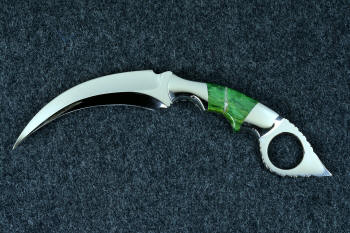
"Raptor"

Aegir is the name of an old Teutonic god of the sea. It is also the root name of aegirine, one of the predominant minerals in the newly discovered gemstone, Nebula Stone. The idea and character of the mythological Norse god was the inspiration for this work of edged art and knife sculpture I call Aegir.
My passion for new gemstone and my pleasure and career as a lapidary was the first consideration, truly, I wanted to create a work of sculptural art in the form of a knife that was suited for Aegir himself. Since this is the very first knife in human history to have a Nebula Stone handle, I wanted to create something very special to debut the newly discovered gem. There were many ideas and creative aspects that went into this piece, unique efforts that will never come together in this way again.
The knife blade was designed just for this project. I wanted the knife to have all the appearance and aspects of dark water, a swirling, rolling group of waves, combined into one rich and expressive form. Since Aegir would reside in the deepest, darkest recesses of the great sea, and since aegirine is a richly black dense mineral, I made the blade with blued O1 high carbon, tungsten-vanadium tool steel. This was an extremely challenging blade to make, the curves are severe, and I wanted every possible surface mirror polished, including the inside of the cuts in the blade spine. I spent many hours working the hardened steel blade up to a brilliant polished finish, and then topped it off with a deep, penetrating hot blue, for the appearance of polished black wet glass.
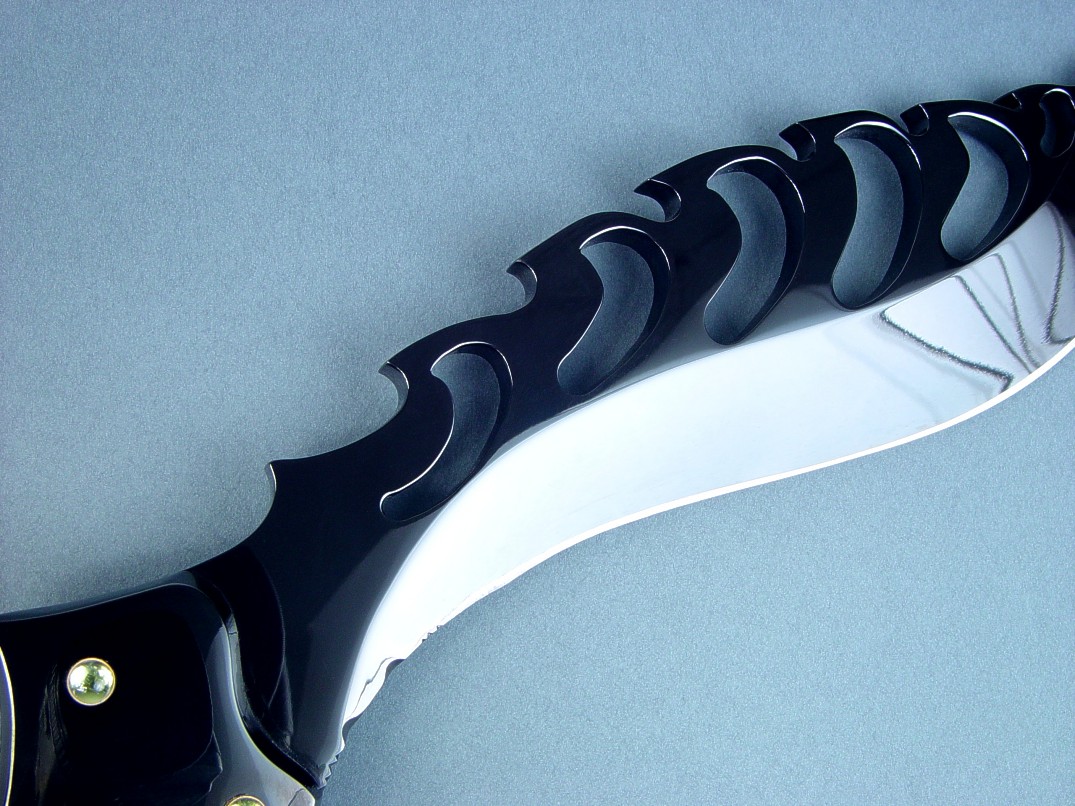
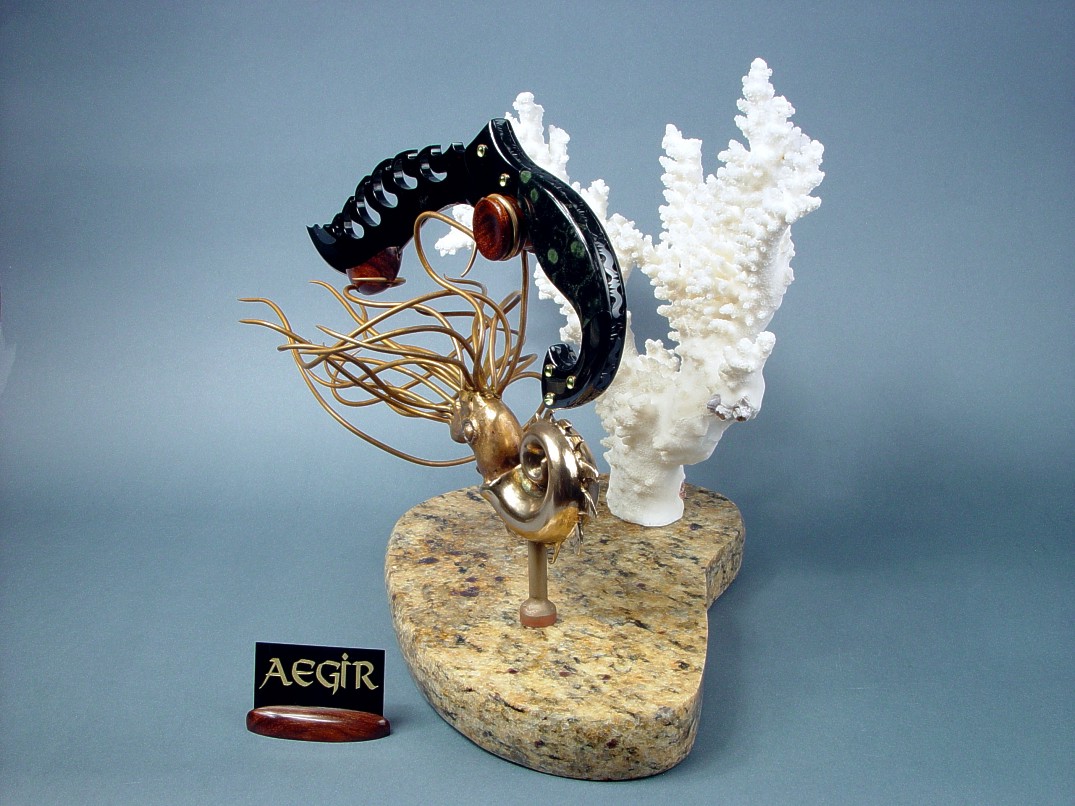
Like most of my works, I'm very proud of the accurate, clean, and sharp grinds, shaping, contouring and finishing of the blade, and this one is especially fine. The blade is hollow ground throughout, with matching grinds and flowing, sweeping grind terminations that echo the curvature of the profile. Every surface is crisp and clean, and the knife has graduated sculpting at the spine in the wave forms, as well as hand-cut, milled, ground, and polished waves through the spine. The hollow grind leads off with an elegantly curved tip, and the cutting edge is bright and razor keen, hand-sharpened with a single bevel. The blade tang is fully fileworked, with a cresting wave pattern. The tang of the knife was left at full thickness to balance the blade size and weight, making the equilibrium point right at the front of the forward quillon.
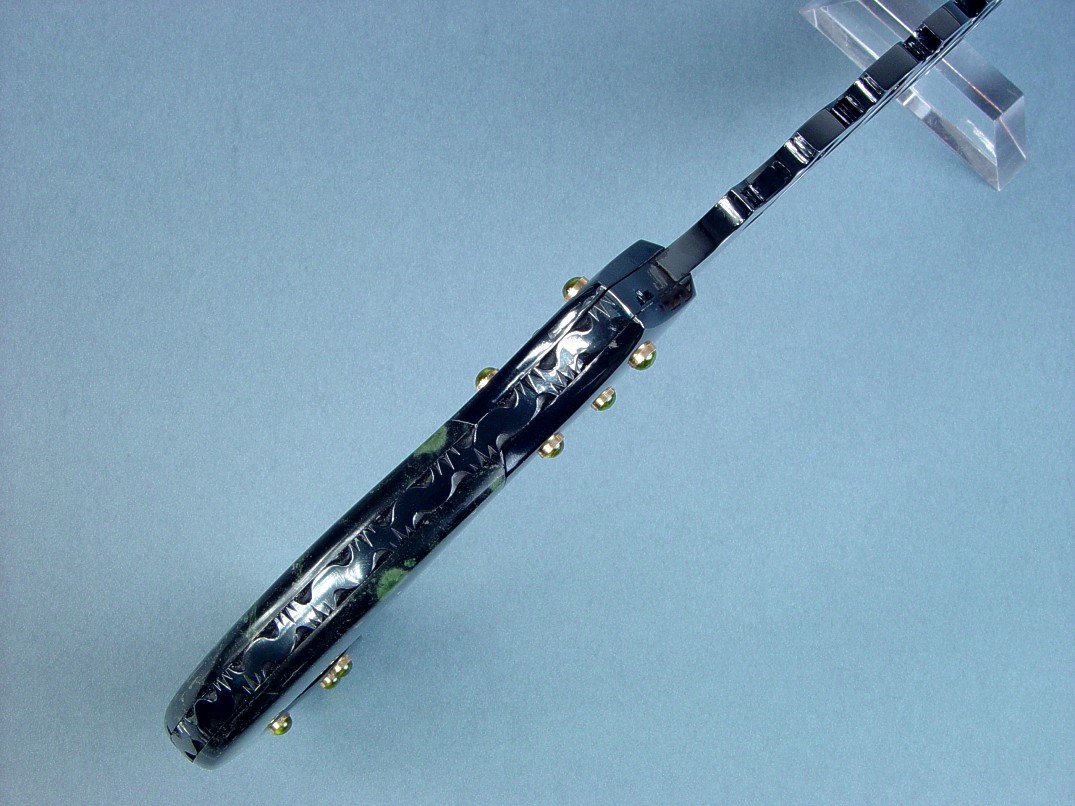

The wild curves of the handle required some very special treatment, as I wanted the bolsters as well as all metal parts of the knife to have the same, deep penetrating mirror black finish. The blade would have to be made and pre-finished, The bolsters attached, the gemstone attached temporarily, the entire blade, bolsters, and handle finished, the entire assembly taken apart, the blade heat treated, polished and finished, the components all polished and finished, hot blued where needed, and then accurate reassembly of the entire piece would top it off. Consequently, this is one of the hardest knives to build. The bolsters are contoured, polished, finished and attached with stainless steel machine screws, and capped with 14 kt. gold cup bezels that hold 12 solid Peridot gemstone cabochons. The Peridots (Olivine) have the light sea-green color I wanted to accent the black base, while echoing the rounded forms of the fascinating green patterns of the Nebula Stone. This Peridot comes from an island in the Red Sea, and is also called evening emerald because it darkens at night. How fitting these gemstones are for Aegir and I couldn't help but think of green eyes of a creature of the sea staring from the abyss.
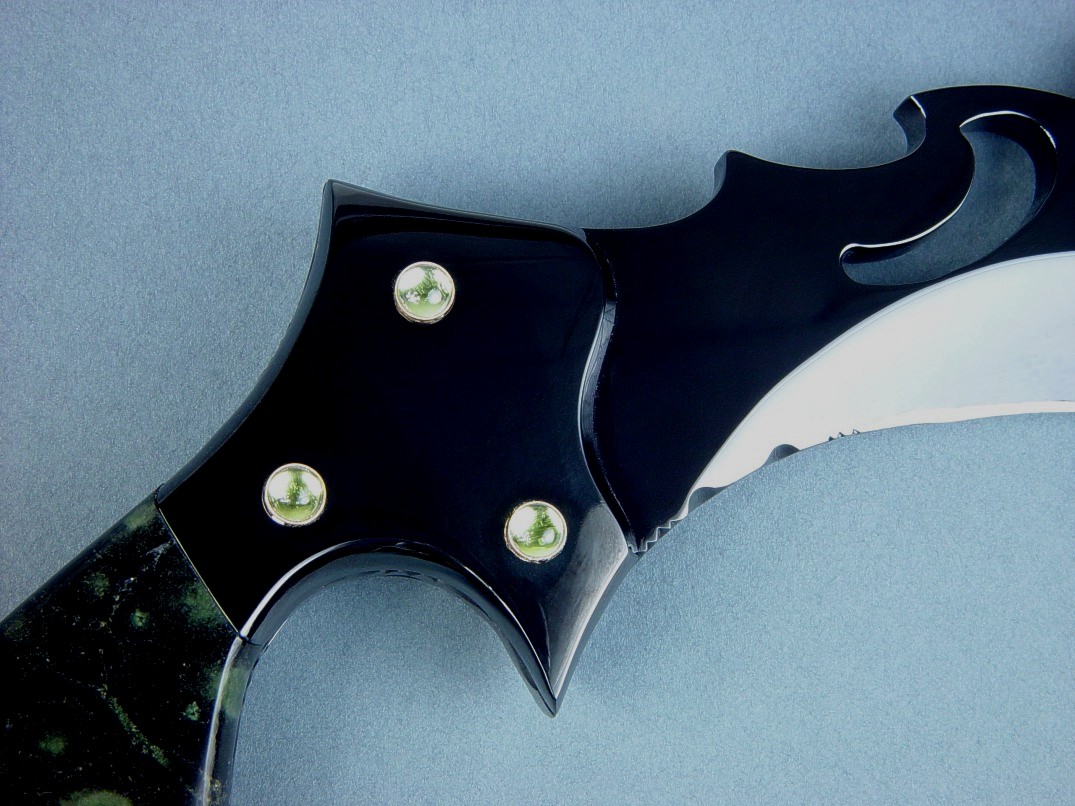
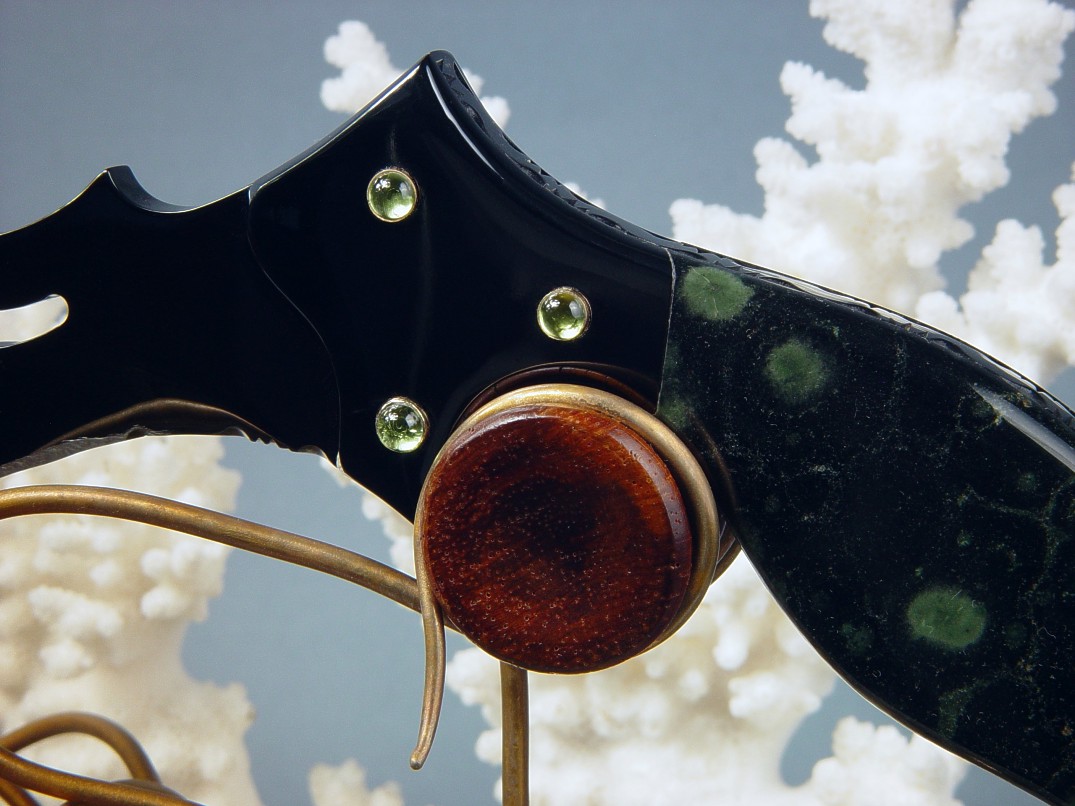
The handle of Aegir is very unique indeed. I can comfortably claim that this is the first knife in history to have a Nebula Stone gemstone handle, since the discovery of this new gem is very recent. There is only one source and he has not supplied Nebula Stone material to any other knife maker or knife artist. This is the main reason I created Aegir, to preview this rare discovery. The Nebula Stone handle scales are a fascinating gem, composed of quartz, zircon, anorthoclase, riebeckite, and, of course, aegirine (acmite). This mysterious stone lacks a defining classification; some call it a jade, but scientists generally agree that it is a new, exciting find. The discoverer of the gem named it Nebula Stone, because the green orbs floating in black space appear to be nebula like, with scatterings of star-like mist circling the nebulas. The gem is hard, tough, and takes a bright, smooth and lustrous polish, and will outlast us all! I could imagine a Norse god of the sea taking a special liking to this unique material. (References and links to more information about Nebula Stone below).
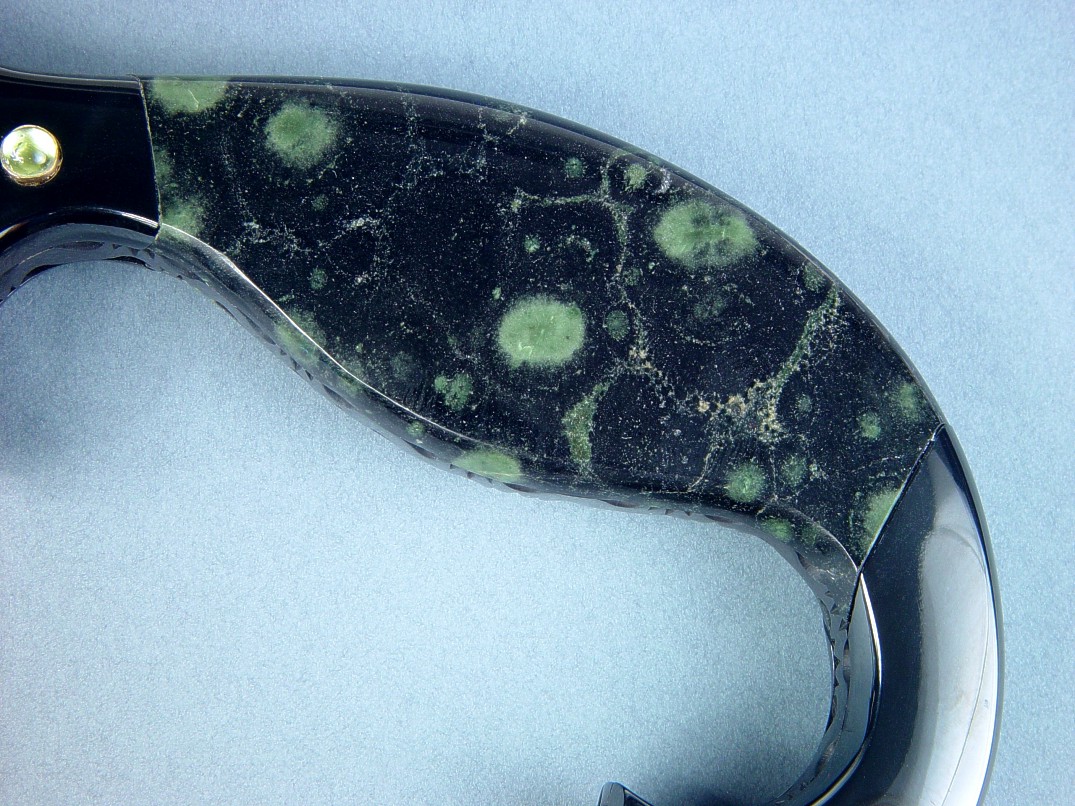

With full and detailed contouring and radiusing, the knife feels comfortable and easy in the hand. The shape of the handle is inviting, and the thumb is naturally drawn over the front bolster at the rise. The angle of the blade to handle places the wrist at ease, and the weight of the knife reminds you that it is a substantial work of art. It is one of the most striking forms I've ever created, and so to complete it, I let the knife and theme guide the effort.

I knew the knife must have a suitable display, much more than that, it needed a clear context related to its very name. In my mind was an image of an ancient, prehistoric chambered nautilus I had once read about, a creature long lost to history, and only lightly represented by the one we know today. In the study of fossils, we see these commonly, and they were large, impressive cephalopods that once ruled the domain of the prehistoric seas. The curvature of the knife, the darkness of the ocean, and it was clear to me what I needed. I needed Aegir to be carried on the tentacles of a mystical creature of the deep.
I sculpted the prehistoric nautilus in wax, and then cast the sculpture in bronze. I made no molds, this was to be a singular, lost wax process sculpture, never to be repeated. I took some liberties with the nautilus form and let my imagination create what I needed for the artwork. I added some fins on the shell, (from an illustration of a prehistoric nautilus), and gave my creature an extra length measure of tentacles for its task. Although I created a creature of over 20 tentacles, it was much more manageable than the modern creature which has 94! I also gave my creature large and serious eyes, and a bit of a beaked mouth. I cast the sculpture in bronze, polishing the shell brightly, but gave a coarser, living texture to the animal within. The creature embraces a windlass spool and a boat of carved Honduras Rosewood, on which Aegir solidly rests.
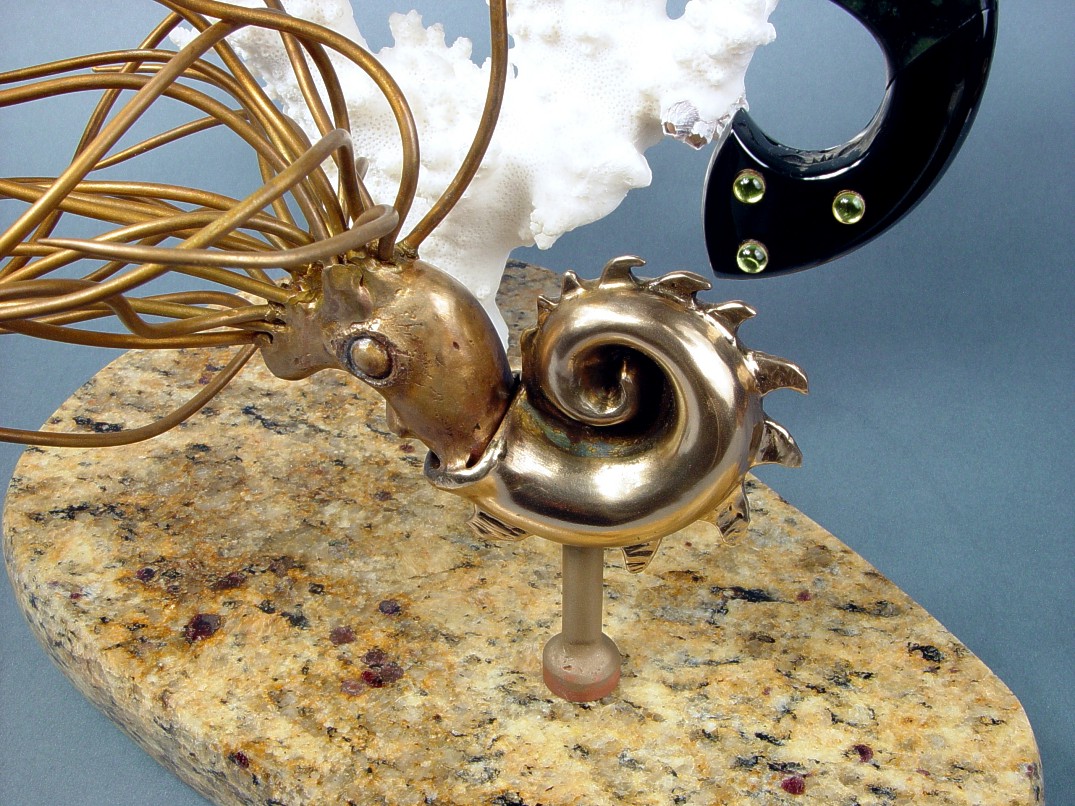
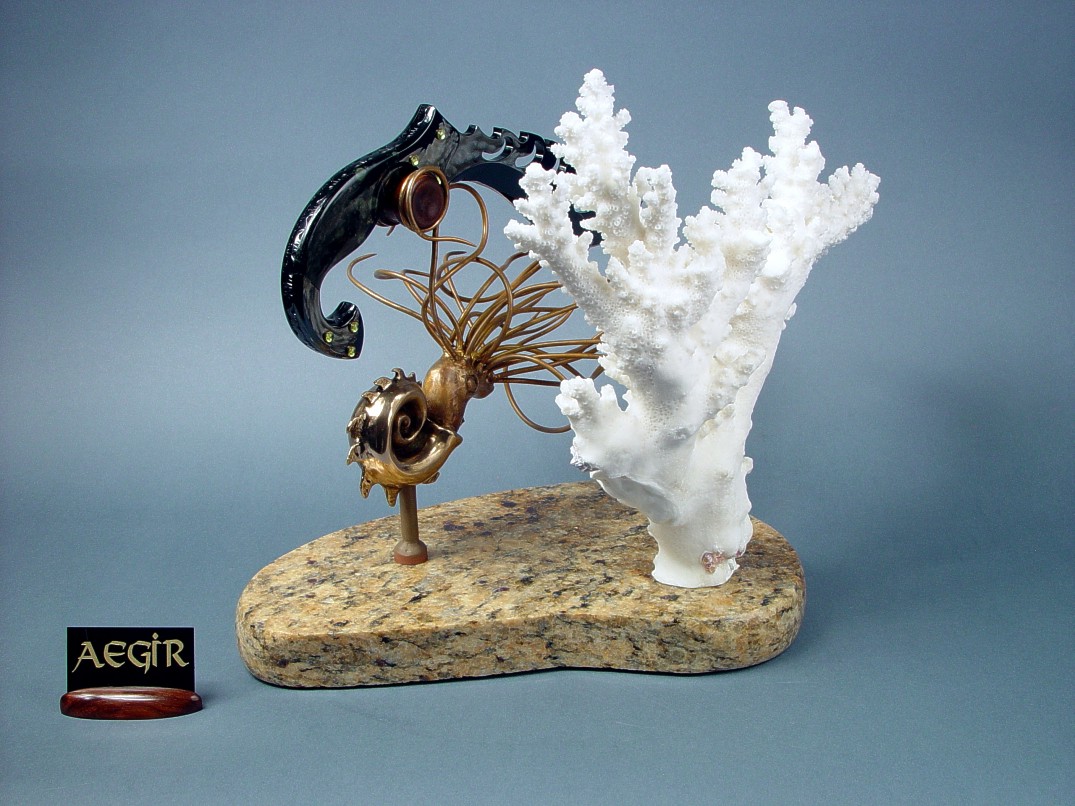
The sea creature secures the knife well, though the tentacles are thin, they are very stout and solid, and the forefinger area as well as the blade contact keep the knife secure, yet easy and quick to remove. The bronze casting is pressed onto a bronze and copper threaded stud mounted to the base, so the nautilus could be repositioned a bit to suit the taste of the owner. I knew that the form of the sculpture must be framed, for perspective, for balance, and for a harmonious display. I needed just the right form and material to establish the contrast and dark richness of the knife. I chose a backdrop of white Caribbean coral, intricate and detailed, to mount behind the bronze and blued steel. The coral is bolted to the base with a set-in, permanent keyed anchor.
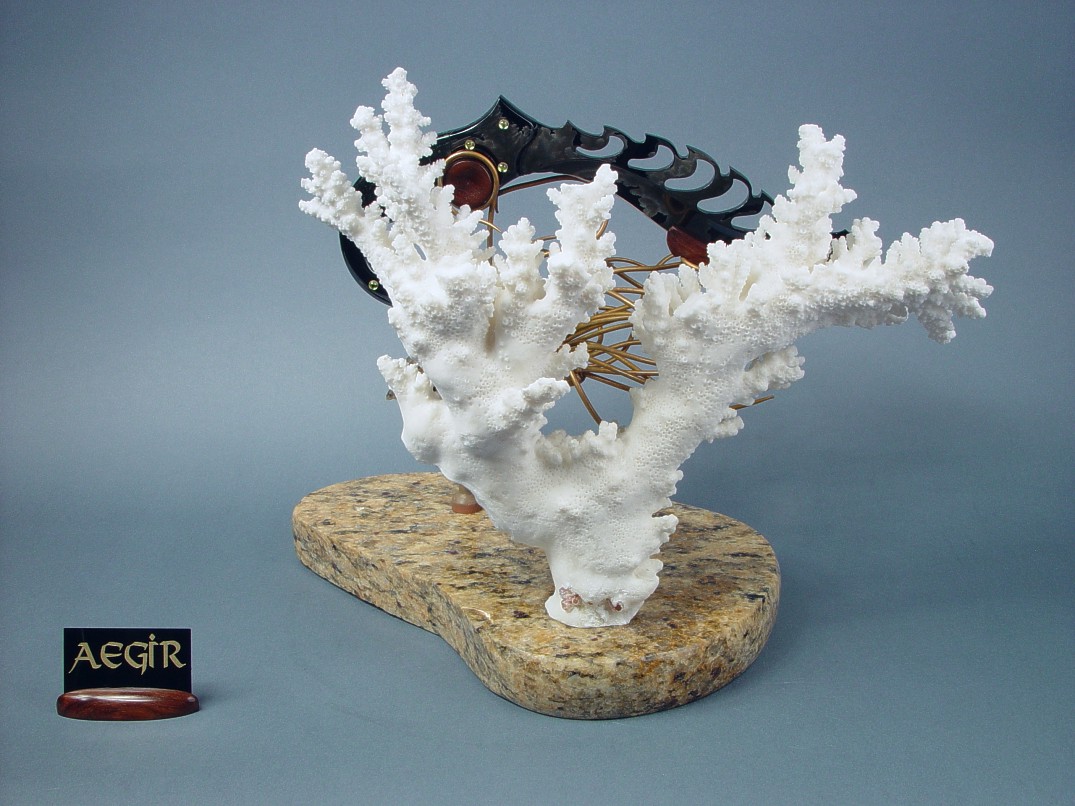
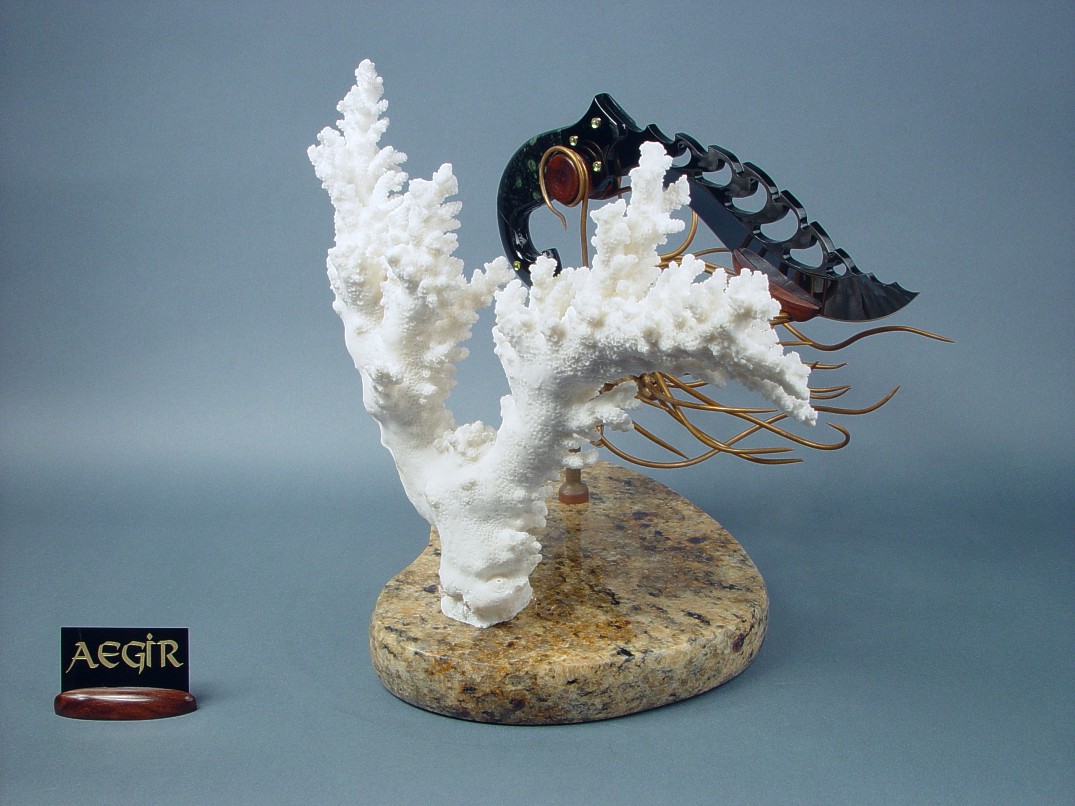
The base had to reflect the beauty of the sculptural work without detracting, while offering its own flavor and charm. I chose a material that looks like beach sand, Venetian Gold Granite from Brazil. I polished the surface, and hand-carved the edges in a convex/concave fashion, polished to a high luster. This granite has numerous solid deep red garnets, that offer a bit of rich color, and it is heavy and tough. The components are bolted through, and the base has inset neoprene feet to prevent marring of any surface the heavy sculpture rests upon. I finished the sculpture with a nameplate of black lacquered brass engraved in a Viking font with the name, set into a small overturned boat of polished Honduras Rosewood.
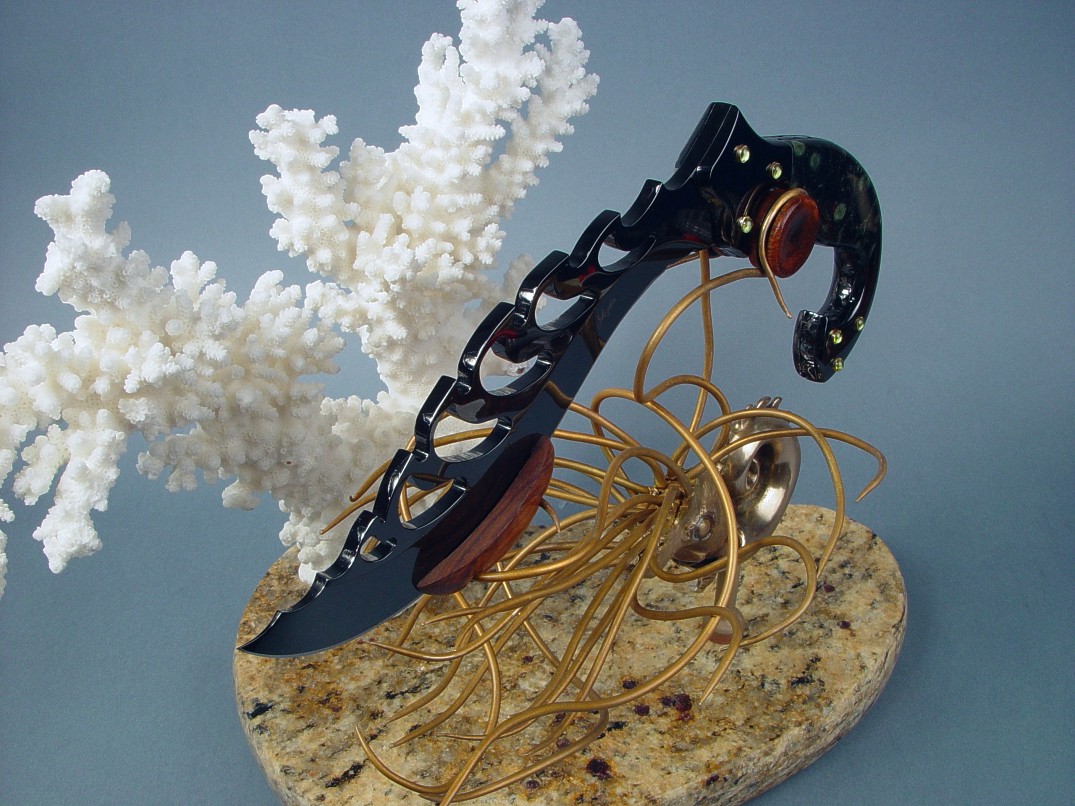
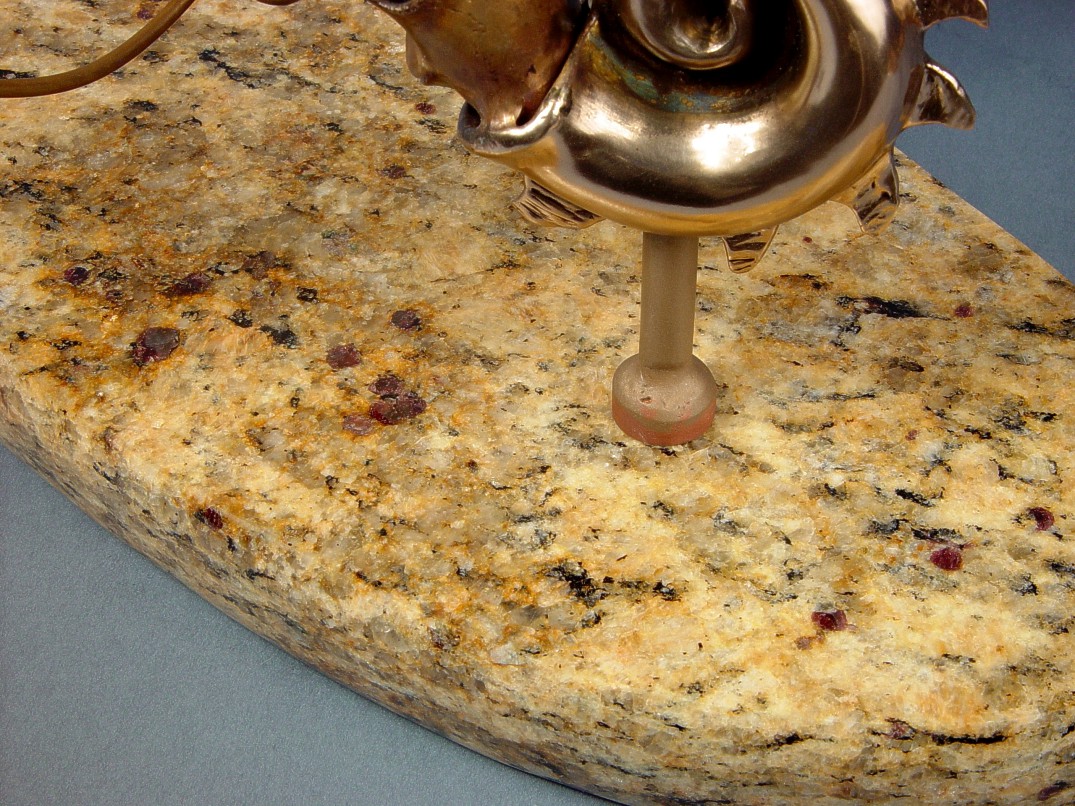
Thanks, G. L.!
Jay,
My thanks to you as well for taking the time from your busy schedule to visit with us, and for the inspired creation, extraordinary
craftsmanship, and delivery of the Aegir - it is a truly wonderful and unique work that I shall enjoy for the rest of my days,
and is now comfortably ensconced in my living room where I can view it every day from the comfort of my favorite chair.
--G. L.
| Main | Purchase | Tactical | Specific Types | Technical | More |
| Home Page | Where's My Knife, Jay? | Current Tactical Knives for Sale | The Awe of the Blade | Knife Patterns | My Photography |
| Website Overview | Current Knives for Sale | Tactical, Combat Knife Portal | Museum Pieces | Knife Pattern Alphabetic List | Photographic Services |
| My Mission | Current Tactical Knives for Sale | All Tactical, Combat Knives | Investment, Collector's Knives | Copyright and Knives | Photographic Images |
| The Finest Knives and You | Current Chef's Knives for Sale | Counterterrorism Knives | Daggers | Knife Anatomy | |
| Featured Knives: Page One | Pre-Order Knives in Progress | Professional, Military Commemoratives | Swords | Custom Knives | |
| Featured Knives: Page Two | USAF Pararescue Knives | Folding Knives | Modern Knifemaking Technology | My Writing | |
| Featured Knives: Page Three | My Knife Prices | USAF Pararescue "PJ- Light" | Chef's Knives | Factory vs. Handmade Knives | First Novel |
| Featured Knives: Older/Early | How To Order | 27th Air Force Special Operations | Food Safety, Kitchen, Chef's Knives | Six Distinctions of Fine Knives | Second Novel |
| Email Jay Fisher | Purchase Finished Knives | Khukris: Combat, Survival, Art | Hunting Knives | Knife Styles | Knife Book |
| Contact, Locate Jay Fisher | Order Custom Knives | Serrations | Working Knives | Jay's Internet Stats | |
| FAQs | Knife Sales Policy | Grip Styles, Hand Sizing | Khukris | The 3000th Term | Videos |
| Current, Recent Works, Events | Bank Transfers | Concealed Carry and Knives | Skeletonized Knives | Best Knife Information and Learning About Knives | |
| Client's News and Info | Custom Knife Design Fee | Military Knife Care | Serrations | Cities of the Knife | Links |
| Who Is Jay Fisher? | Delivery Times | The Best Combat Locking Sheath | Knife Sheaths | Knife Maker's Marks | |
| Testimonials, Letters and Emails | My Shipping Method | Knife Stands and Cases | How to Care for Custom Knives | Site Table of Contents | |
| Top 22 Reasons to Buy | Business of Knifemaking | Tactical Knife Sheath Accessories | Handles, Bolsters, Guards | Knife Making Instruction | |
| My Knifemaking History | Professional Knife Consultant | Loops, Plates, Straps | Knife Handles: Gemstone | Larger Monitors and Knife Photos | |
| What I Do And Don't Do | Belt Loop Extenders-UBLX, EXBLX | Gemstone Alphabetic List | New Materials | ||
| CD ROM Archive | Independent Lamp Accessory-LIMA | Knife Handles: Woods | Knife Shop/Studio, Page 1 | ||
| Publications, Publicity | Universal Main Lamp Holder-HULA | Knife Handles: Horn, Bone, Ivory | Knife Shop/Studio, Page 2 | ||
| My Curriculum Vitae | Sternum Harness | Knife Handles: Manmade Materials | |||
| Funny Letters and Emails, Pg. 1 | Blades and Steels | Sharpeners, Lanyards | Knife Embellishment | ||
| Funny Letters and Emails, Pg. 2 | Blades | Bags, Cases, Duffles, Gear | |||
| Funny Letters and Emails, Pg. 3 | Knife Blade Testing | Modular Sheath Systems | |||
| Funny Letters and Emails, Pg. 4 | 440C: A Love/Hate Affair | PSD Principle Security Detail Sheaths | |||
| Funny Letters and Emails, Pg. 5 | ATS-34: Chrome/Moly Tough | ||||
| Funny Letters and Emails, Pg. 6 | D2: Wear Resistance King | ||||
| Funny Letters and Emails, Pg. 7 | O1: Oil Hardened Blued Beauty | ||||
| The Curious Case of the "Sandia" |
Elasticity, Stiffness, Stress, and Strain in Knife Blades |
||||
| The Sword, the Veil, the Legend |
Heat Treating and Cryogenic Processing of Knife Blade Steels |